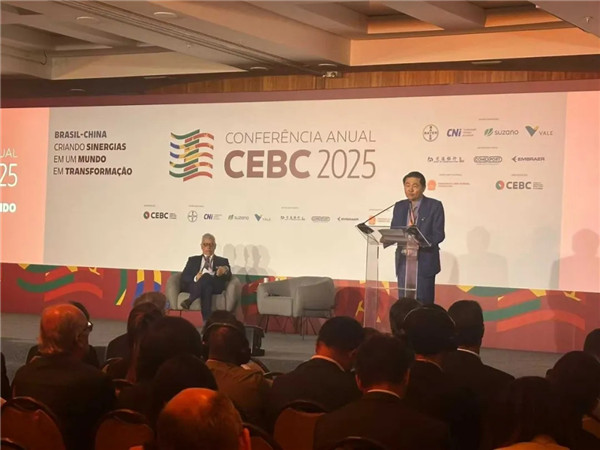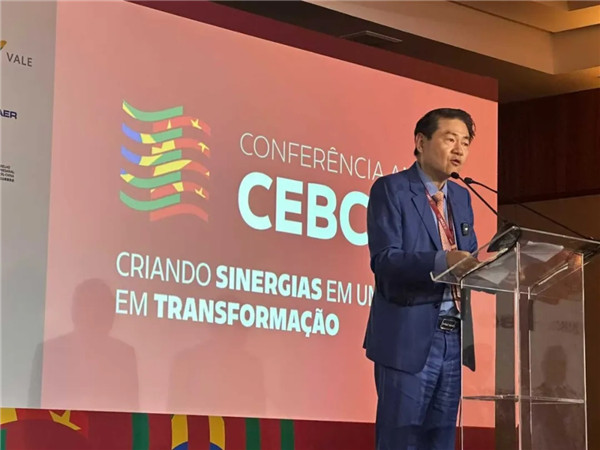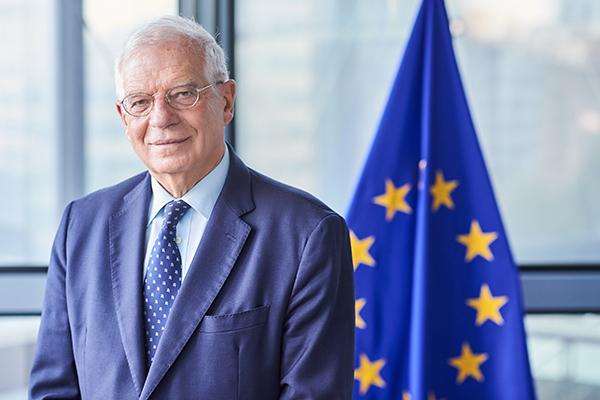Wang Huiyao: China and Brazil in a New Phase of Partnership: From Broad Trade to Deep Economic Cooperation
October 13 , 2025

Your Excellencies, Ambassador Luiz Augusto de Castro Neves, Ambassador Marcos Caramuru, and Ambassador Zhu Qingqiao,
Distinguished senior government officials, ambassadors, business leaders, friends, ladies and gentlemen.
Good morning. It is a great pleasure to join you here in São Paulo for this year’s annual Brazil–China Business Council Conference. I wish to thank the Council, its leadership, and secretary general, who have worked tirelessly to build the bridges that connect our economies and our peoples.
This year marks a significant moment in the 50-yeardevelopment of Brazil–China relations. For half a century, our nations have walked side by side through transformation and modernization. We began as partners in commodities and manufacturing trade. Today, we stand as collaborators in manufacturing, innovation, green growth, and global governance. We are indeed entering a new phase of partnership — from broad trade to deep economic cooperation.

Shared Achievements and Deepening Ties
Brazil is China’s largest trading partner in Latin America, and China has been Brazil’s top trading partner for 15 consecutive years. Bilateral trade surpassed USD 180 billion in 2024, representing nearly one-third of Brazil’s total global trade. China imports Brazilian soybeans, iron ore, oil, beef, and poultry and in turn, exports machinery, electronics, and increasingly electric vehicles and digital products.
Now, Chinese firms are moving beyond trade into diversified economic cooperation in a record 39 projects in Brazil across a more diverse array of industries, reaching a total of 4.2 billion dollars, found in a CEBC study released recently.
Chinese investment in Brazil now stands in excess of USD 79 billion since 2007, and it continues to diversify. More than ten thousand kilometers of transmission lines have been built, including the Belo Monte–Rio de Janeiro ultra-high-voltage corridor, which powers millions of homes. SPIC — the State Power Investment Corporation — has invested in wind and solar farms across Bahia and Paraíba and has recently put 147 million dollars’ worth of assets towards two new wind energy projects in Rio Grande do Norte expected to begin operations in 2026.
In Bahia, where the sun beats strong and the sea wind never rests Chinese and Brazilian Engineers have revived the once idle Ford plant in Camaçari, bringing thousands of new jobs in BYD’s electric-vehicle and battery complex. It is a symbol of renewal and of green innovation and green growth that is bringing prosperity. With the first locally assembled BYD Dolphin Mini rolling off the line in July 2025. Today the plant’s solar-powered assembly lines and locally sourced lithium-iron-phosphate batteries now serve not only Brazil’s domestic market but also export hubs across the Americas. The green cooperation between China and Brazil is enormous!
And this story does not stand alone. In São Paulo state, Great Wall Motors has undertaken a similar transformation, refurbishing the former Mercedes-Benz facility in Iracemápolis into a new hub for hybrid and electric vehicle production
At the same time Huawei continues to partner with Brazilian operators to advance 5G connectivity and train local engineers. And companies such as CRRC and China Communications Construction Company are exploring infrastructure partnerships that can modernize Brazil’s logistics network. In addition digital companies such as, Tik-Tok, 99 (Didi), Keeto (Meituan), and Kwai (Kuaishou) are all expanding investment into Brazil.
A Shared Vision in a Changing World
The world economy is undergoing profound change. Protectionism and unilateralism have resurfaced; supply chains are being redrawn; the digital and green transitions are reshaping competition. Amid these shifts, China and Brazil — as major emerging economies and members of BRICS — stand together as stabilizing forces committed to openness, inclusivity, and sustainable development.
Together we face the same challenges, and together we share the same vision. Last Month BRICS Leaders had a virtual summit where both President Xi and President Lula made great remarks on BRICS new role in our turbulent world.
Both nations share a belief that the 21st century should not be defined by confrontation, but by cooperation. Both nations have faced the same countervailing winds. Within BRICS, within the G20, and within multilateral frameworks, Brazil and China have consistently advocated fairness, reform, and a stronger voice for the Global South.
Six Pathways Toward Deeper Strategic Cooperation
Today, allow me to outline six areas where we can turn shared vision into concrete action.
First, we should deepen infrastructure collaboration — the backbone of economic integration. Here China’s experience has already been felt ranging from transmission lines ranging from transmission lines that span thousands of kilometers, to port modernizations and highway upgrades built in partnership with Brazilian counterparts. But it can yet grow further and bring with it greater opportunities fom high-speed rail, smart ports, and logistics corridors can align with Brazil’s national development priorities. Together we could start a flagship high-speed modern rail corridor linking São Paulo and Rio de Janeiro. A project that would reduce freight congestion, cut carbon emissions, and stimulate new industries.
Second, let us strengthen financial cooperation by expanding the use of local-currency settlement, particularly the Renminbi (RMB) and the Brazilian Real reducing dependence on a single currency, lowering transaction costs, giving exporters greater flexibility, and increasing resistance to economic shocks.
Local-currency settlement between the RMB and Real is expanding rapidly, since mid-2023 more than 30 percent of bilateral trade invoices have been settled directly without U.S.-dollar mediation. Establishing RMB-clearing banks in São Paulo and Rio would help institutionalize this shift as well as further stabilize trade, hedge exchange-rate risk, and encourage cross-border investment funds dedicated to green infrastructure and digital start-ups.
Third, we must seize the momentum of the green transition and green growth. Brazil’s New Industry Plan and Accelerated Growth Program (PAC) aim to reindustrialize with green and digital priorities. Joint laboratories — for example, between SENAI Cimatec and Huawei or between EMBRAPII and Chinese AI firms — could accelerate Brazil’s “Industry 4.0” transition while giving Chinese partners a springboard for Latin America’s innovation market.
All the while Brazil’s rich renewable resources — hydropower, wind, solar, and biofuels — present an incredible opportunity and complement China’s strengths in renewable technology production and financing.
Already electric cars and joint ventures such as SPIC’s renewable parks and CTG Brasil’s hydro assets point to the potential. The next frontier should include green hydrogen production, smart grids, and joint research on carbon capture and storage.
Together, we can make the Brazil–China partnership a global model for sustainable industrialization.
Fourthly, we should expand cooperation in the digital economy, artificial intelligence, and robotics.
Huawei’s 5G rollout, Alibaba Cloud’s regional services, and partnerships with Brazilian fintech firms show how innovation can drive inclusivity. From integration of new platforms that leverage data and network effects like 99 (Didi), Tik-Tok, Keeto (Meituan), and Kwai (Kuaishou) to the building of new joint digital-innovation centers — for example, in agritech, healthcare, and smart logistics — we can harness both countries’ talent and data strengths.
Here too China’s synergies and new wave of sustainable quality development can find a natural partner in Brazil’s emerging technology sectors. With China’s existing strengths in AI, robotics, automation, and scale enabling Brazilian agritech and industrial firms among others to leapfrog development through joint labs, hardware transfer, and co-investment.
Fifth, we should broaden people-to-people connections. The number of Chinese visitors to Brazil remains far below potential, while Brazil’s rich cultural and natural diversity makes it a prime destination. Expanding direct flights, simplifying visa procedures, and launching joint promotional campaigns would greatly increase two-way travel.
On education, more scholarships, student exchanges, university partnerships, and Portuguese–Chinese language programs can build mutual understanding and prepare the next generation for cross-continental cooperation.
Finally, we should deepen academic and thinktank exchange.
Institutions such as the Center for China and Globalization (CCG) a top 100 Think Tank with UN secial consultative status and the Brazil–China Business Council (CEBC) and the Brazilian Center for International Relations (CEBRI) are already playing this bridging role. By establishing a regular Brazil–China Think-Tank Forum, we can foster dialogue on issues ranging from global governance reform to trade facilitation and investment to sustainable finance.
Partnerships and joint policy research will ensure that business and government decisions are informed by fresh, evidence-based perspectives. People-to-people diplomacy — through media, arts, and cultural programs — can complement these efforts, strengthening public trust on both sides.
Conclusion: A Partnership for the 21st Century
China and Brazil have proven that the partnership between two great developing nations can be both pragmatic and visionary. From the first soybean shipments decades ago to today’s joint ventures in the digital realm, EVs, and AI, our cooperation has grown broader, deeper, and more resilient.
Today Brazil stands as an ideal location for China’s manufacturing investment. Yet In this new phase, let us continue to look beyond the horizon — to build railways of connection, digital bridges of innovation, and green corridors of growth. Let us make our bilateral partnership not only a success story for our peoples, but also a source of inspiration for the entire Global South.
Together, we can ensure that the next fifty years of China–Brazil relations will be defined not merely by investment and trade flows, but by shared development, shared responsibility, and shared prosperity.
Thank you.
Topical News See more






